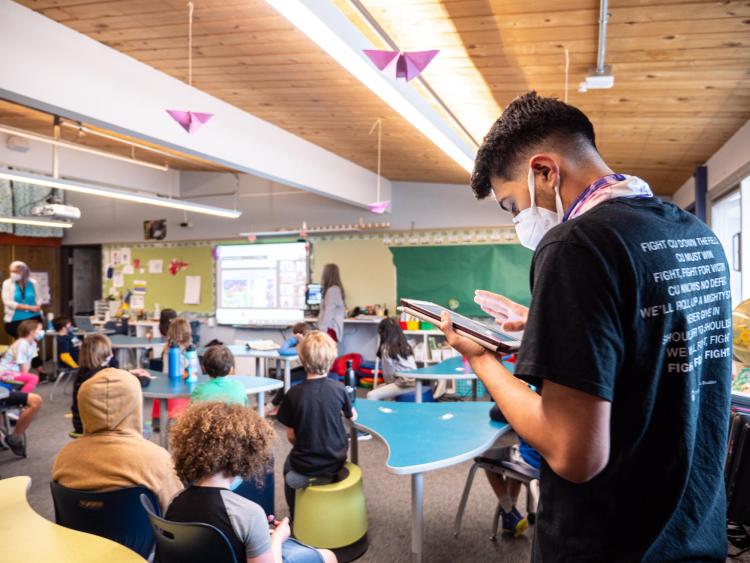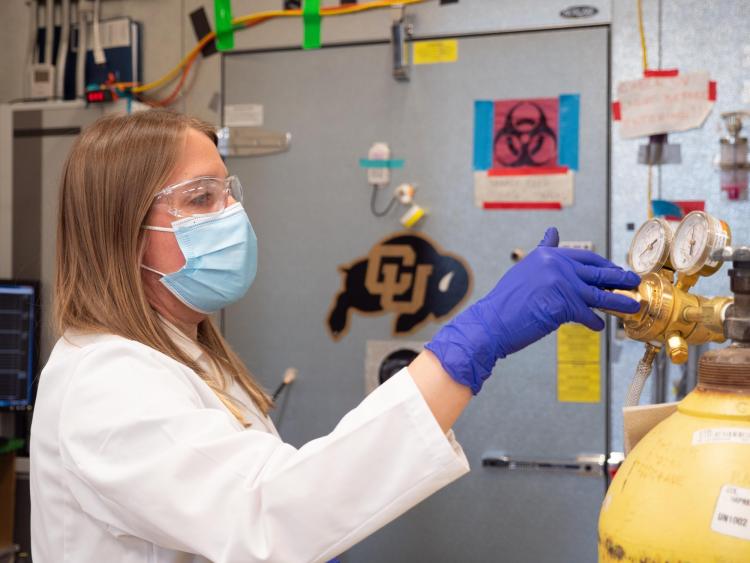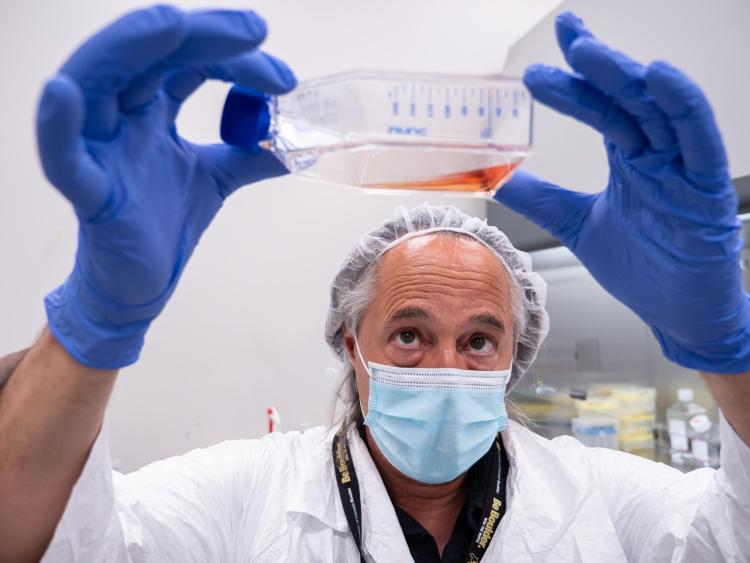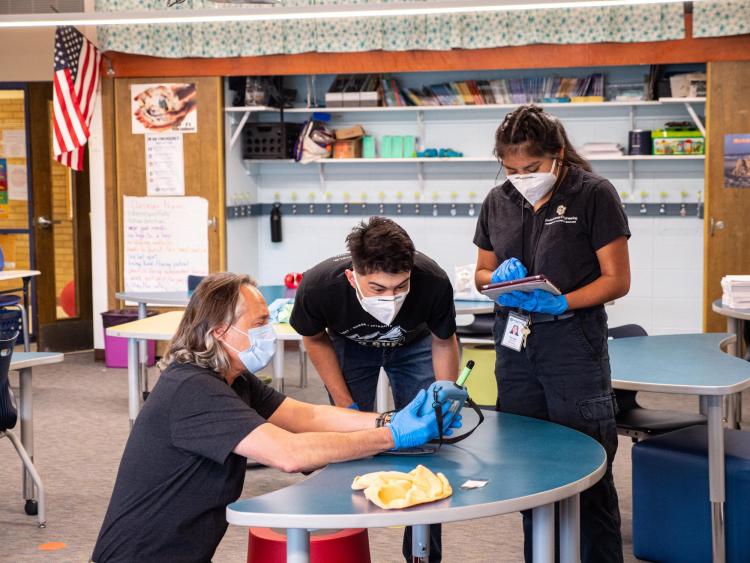Better air quality in some Colorado schools will last long after the pandemic
Banner image: CU Boulder alumna Halle Sago, left, and undergraduate student Ricardo Reyes, right, visit High Peaks Elementary School in Boulder, Colorado, to monitor air quality. (Credit: Glenn Asakawa/CU Boulder)
School may be out for summer, but cleaner indoor air may be here to stay in some Colorado classrooms.
With support from the heating and ventilation company Carrier Global, Intel and the Colorado-based Ryan Innovation Group, engineers at CU Boulder have installed hundreds of air quality monitors in K-12 classrooms across Denver and Boulder. The project is led by Mark Hernandez, professor in the Environmental Engineering Program at CU Boulder.
The team is made up of a diverse group of young researchers, including Spanish speakers and immigrants to the United States. It draws on the real-time data from these devices to help schools track and improve the ventilation within their buildings, using tools that anyone can buy online. Hernandez' research is showing that, for less than $100 per student, schools may be able to improve air quality in ways that can not only dramatically slow the spread of COVID-19 in classrooms—but can help protect kids and school staff from pollutants that cause asthma and a range of other illnesses.
“We as a collective society need to pay more attention to where we spend most of our time, from schools to offices,” Hernandez said. “We have a lot of choices about the water we drink, but we have no choices about the air we breathe.”
Those choices were on display in High Peaks Elementary School in Boulder—one of dozens of schools that Hernandez worked with in 2020 and 2021 to help bring back students amid a pandemic.
In one second grade classroom—where a sign on the wall cautions “no high fives or hugs”— Hernandez pointed to the key to that work: a white device about the size of a wireless router hanging above the doorway.
“That’s an air monitor,” said Hernandez, professor in the Environmental Engineering Program at CU Boulder. “It tells us certain aspects related air quality in this room in real time.”
The device, Hernandez explained, measures the constantly shifting levels of carbon dioxide gas and airborne particles in this learning space.
Amanda Fox is a fifth grade teacher at Boulder Community School of Integrated Studies, which shares a building with High Peaks. Young people and their parents had a lot to worry about this year, she said. She’s happy, at least, that the air they breathed wasn’t at the top of their list.
“Feeling safer in your environment is such an important part of being able to learn,” Fox said.
[video:https://youtu.be/wtNvKCzzuT0]
Mouse viruses
The work has continued even as students at High Peaks and other K-12 schools have left for the summer.
Odessa Gomez, a senior researcher in Hernandez’ group, is standing in front of a room in a lab on the CU Boulder campus that looks like a walk-in refrigerator. It’s an advanced incubator, an airtight space where Gomez and her colleagues can precisely control the humidity and temperature of the environment—allowing them to replicate the conditions in indoor spaces like school classrooms or hotel suites.
By way of a series of pumps, Gomez introduces a liquid culture containing trillions of coronaviruses into the machine.
“It’s a mouse virus, so it can’t affect us,” Gomez clarified. “But it’s a good model for COVID-19.”
Top: Odessa Gomez checks settings on a lab incubator; middle: Mark Hernandez inspects a culture of brain cells infected with mouse coronavirus; bottom: From left, Hernandez, Ricardo Reyes and Halle Sago take microbial counts on a classroom desk before and after cleaning. (Credits: Glenn Asakawa/CU Boulder)
Gomez and her colleagues are trying to understand how long coronaviruses can survive in indoor environments—and, especially, how they survive in aerosols, such as the microscopic drops of liquid that humans inhale and exhale with every breath. The more you can remove such droplets from the air, scientists are discovering, the more you can reduce the risk of COVID-19 spreading from person to person.
The group’s preliminary results, for example, suggest that these viruses last longer in dry environments than under humid conditions. Recently, two other researchers at CU Boulder called for international organizations to better regulate indoor air quality as a means of combatting airborne diseases.
“The coronavirus pandemic has absolutely brought indoor air quality to the forefront of everyone’s minds,” Gomez said.
Hernandez agreed. The environmental engineer has wavy gray hair that almost reaches his shoulders, which he refers to as his “COVID haircut.” The tongue-in-cheek comment belies a sadder story: Several months into the pandemic, Hernandez learned that the woman who had cut his hair for 10 years had died of COVID-19.
“I think everyone has a story like that this year,” he said.
But when the pandemic hit in 2020, Hernandez also realized that he could do something about it.
He’s spent decades thinking about the links between indoor air quality and human health—and has examined everything from how odors in sewage treatment plants might affect workers to the potential for biological warfare in the years after 9/11.
“These issues have been around forever,” he said. “Unfortunately, COVID has brought a new awareness around indoor air quality.”
Droids in the classroom
Back at High Peaks Elementary, Hernandez flipped open his laptop to reveal a series of charts.
“Here are all the schools we’ve put monitors in,” he said.
Some of those monitors, like the one in the second-grade classroom, track carbon dioxide and airborne particle concentrations in real time. Carbon dioxide isn’t harmful on its own, Hernandez said, but it can give you clues about the ventilation in an indoor area. When people pack into an enclosed space without good air circulation, for example, carbon dioxide levels begin to build up—and so can the risk that airborne diseases will pass from person to person. Other monitors directly track the flux of aerosols in classrooms.
Hernandez points to one chart with peaks that are higher than the rest.
“That tells me that in this classroom, the ventilation isn’t as good as it is in others,” he said.
For months, Hernandez sent a small team of student research assistants to visit 36 schools in Denver and Boulder about once every week. There, the researchers took air quality measurements to supplement the data streaming in from the monitors. That information, Hernandez said, is continuing to help these schools to identify classrooms and buildings where the ventilation systems aren’t performing as well as they would have liked.
In Denver Public Schools, his team took the work one step further. Earlier in the year, the group installed a series of devices called HEPA filters in more than 60 classrooms. The devices, which look a bit like R2D2 and are about the same size, were donated by the Carrier company. Think of them as portable air scrubbers. They suck in air from the classrooms on a constant basis, filtering out particles like the tiny droplets that can carry the coronavirus.
Each of these units retails for about $400, Hernandez said, suggesting that schools can make a real difference in the air their students breathe for a relatively modest investment.
“This project has really made me realize how important the built environment that we live in is for our health,” said Sylvia Akol, an undergraduate student in environmental engineering at CU Boulder and a member of Hernandez’ team. “We really need to assess where the students are studying.”
Joni Rix, environmental program manager for Denver Public Schools, is looking forward to digging deeper into the group’s findings.
“Mark Hernandez’ work will hopefully show district leadership that the HEPA units are another way that we can improve indoor air quality as we look at the next round of federal funding,” she said. “Not just for the pandemic but for staff and students with asthma and the school overall.”
Hernandez, for his part, hopes that when the pandemic is long over, Americans won’t forget the importance of a little fresh air indoors.
“This work is an investment in infrastructure,” he said. “The investment that we’re putting in right now to improve air quality in schools during the pandemic is going to pay back for other challenges in the future that we are bound to face like wildfires and climate change.”






